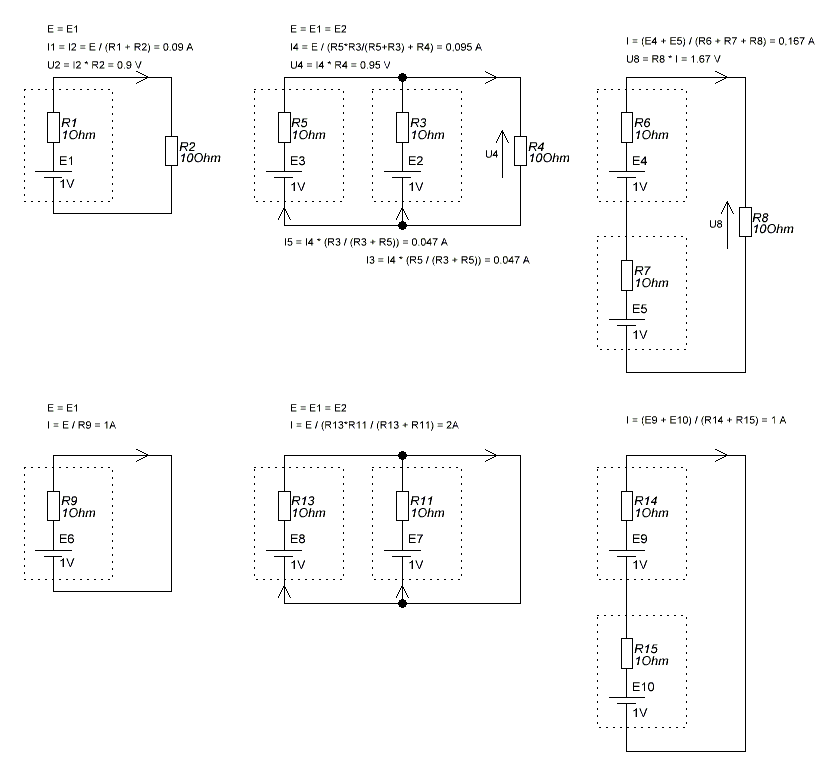Answer the question
In order to leave comments, you need to log in
Why does the current increase when batteries are connected in parallel?
Learning the basics of electricity (in order to play with arduino and raspberries).
Ohm's Law states that Current = Voltage/Resistance.
At the same time, Voltage = Current*Resistance.
And then I read the chapter on series and parallel connection of batteries. It turns out that if you connect the batteries in series, then their voltage is summed up, and the current strength remains the same, and if you connect them in parallel, then the voltage is the same, but the current strength is summed up.
What about Ohm's law? Does our resistance somehow change in this proportion? ..
Or maybe Ohm's law works strictly for specific types of electrical circuits (circuits)? ..
Why does the current strength increase with a series connection with an increase in voltage? .. How does the current increase with a parallel connection without increasing the voltage
?
Answer the question
In order to leave comments, you need to log in
The battery has an internal resistance that limits the current it can deliver in the event of a short circuit. (bottom row) and this resistance increases as it discharges.
But usually this resistance is much less than the load resistance (first row). Then the current will not change much. But the batteries will last longer because each one has less current flowing through it.
In addition to Ohm's law, there are other fundamental rules in electrical engineering.
One of which is Kirchhoff's rule. According to which the sum of the currents flowing into the node is equal to the sum of the currents flowing out, or the algebraic sum of the currents in the node is equal to zero.
Therefore, the current that the battery can supply to the node is added up when additional batteries are connected.
When we talk about current strength in relation to current sources, we mean the maximum current strength that they are capable of delivering without damage. In addition, current sources have their own resistance, which determines the short circuit current. Isc = U/R source.
In this case, the real current strength in the circuit with the load (in the simplest case) is calculated according to Ohm's law for the complete circuit: I = U / (Rload + Rsource). This current must be less than the maximum allowable for the source.
When batteries are connected in series, their voltages are summed up, as are the resistances. But the current in series connection is the same in all sections of the circuit and, accordingly, the maximum current of the connected batteries will be equal to the maximum current of one battery. The real current of the entire circuit I = U*n/(Rload + Rsource*n).
When batteries are connected in parallel, the current will be distributed between them in inverse proportion to their internal resistance. If the batteries are the same, then the circuit current will be divided equally between them and, accordingly, the total current limit of the connected batteries will be equal to the current limit of one battery, multiplied by the number of batteries. The real current of the entire circuit I = U/(Rload + Rsource/n).
This answer may sound like nonsense, but try it.
After it, it becomes clear how the current from the power plant is INSTANTLY in your iron.
I asked myself the answer to the question - where does the current in the outlet come from or even the wording "how many amperes in the outlet". Voltage - we all know 220, which means volts.
One electrician answered me, and at school they said that current is electrons.
I asked - where are the electrons in the socket from?
He answered - they are coming from the power plant.
I asked - where are they from? How to create them? Here, in physics, they took an electrolyte, lowered the wires, so a quarter of a volt turned out there, is there really such a mega vat with electrolyte at the power plant, and it means somehow 220 came out there?
He answered - no, there are generators that create them, the rotation of the frame in a magnetic field, and so on.
I asked - that is, they are taken from the air, from a magnetic field, or what?
Then he answered - yes ... (The answer is no, rotating in a magnetic field, forces pull electrons out of the chaos inside the conductor into a line from plus to minus)
Didn't find what you were looking for?
Ask your questionAsk a Question
731 491 924 answers to any question